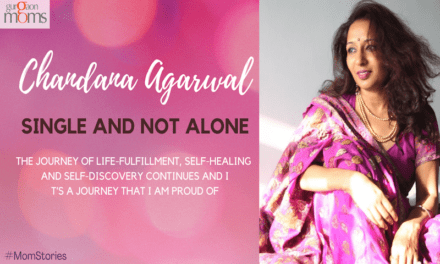When S and I were newly married, we shared our rented apartment with an elderly lady who was the owner of that apartment. What had happened was that the lady was supposed to be leaving in a month or so to stay abroad with her children, but events unfolded such that we all ended up staying together for a much longer time.
It was a very interesting experience to live that way. She was a soft spoken, cultured and well-read lady, and having been a history teacher before her retirement, she regaled us with amazing stories from Indian History at dinnertime, when all three of us sat together at the dining table.
But as it often happens with most people of the previous generation, she too lived with the notion that food was mostly cooked for the pleasure of men. How did I find this out?
In the early days of my marriage, I was staying at home, before I re-joined my job a couple of months later. I used to do all the cooking and washing up myself, and for the first few days, auntie would say in the afternoons: oh, it’s just the two of us, we’ll have leftovers from last night.
Or she would say: Oh, cook all this elaborate stuff in the evening when S comes home.
After a few days, I wondered why the two of us were not worth cooking for, and only S was worth cooking for? So when she said to me that day, ‘oh we’ll have leftovers from last night, S won’t be here anyway’, I laughed and said to her: But auntie we are here! Why should food only be cooked for S? I want to cook for myself and for you as well!
And from then on, I cooked up good stuff for the two of us also. I think she was also trying to be kind to me, and not make me work too hard—trying to make it easy for me by saying that I didn’t need to cook for her. I understand that a lot of it came from a place of kindness wherein she didn’t want me to be exhausted cooking for her.
But I’ve seen this in plenty of Indian homes where the man is considered the primary consumer of food—the food is almost always meant first and foremost for the men.
And the meat—especially the meat! The men are expected to eat a lot of meat, and the women are supposed to not want meat so much. Perhaps it has to do with the belief that meat eating makes you aggressive and dominant- not to mention highly sexual.
Qualities that traditional society wishes to keep away from women.
Well, not this woman.
I love my chicken and my mutton, and am not ashamed of eating as much as I want. (Perhaps that might explain some of my aggression and other interesting qualities. But that’s another discussion.)
So one day, S and I were invited to dinner at an acquaintance’s house. They had cooked shaljam gosht which is practically our favourite meat dish.
Now, the thing is, sucking on mutton bones for bone marrow is considered a delicacy in our culture. So when we sat for dinner, the elderly gentleman asked his wife to ladle out the big bone to S.
“Bhaiyya ko do!” He instructed her. Give it to the young man!
I waited for her to ladle it out to S, while eyeing the other big bone in the curry for myself. But before I had the chance to actually get the bone for myself, the elderly gentleman again urged his wife:
“Doosri wali bhi do bhaiya ko!” Give the other bone, too, to the young man!
Well, really! Why should all the best portions be ladled out to ‘bhaiyya’! Why had he invited me, then? To watch while my husband ate?
Thankfully, however, his wife retorted with: “Arrey woh bhi to khayegi!” indicating me. “But she is eating too, isn’t she!” I cannot explain how happy her answer made me.
Food is not meant for men alone.
More evidence of this attitude can be found in villages, in large joint families, where it is always the women who do all the cooking from dawn to dusk, but are always the last to eat.
The food is served to all the men first, and when they have had their fill of all the freshest and best portions, the leftovers are eaten by the women. Often it happens that very little of the food is left, and the women either have to go back to the kitchen and cook some more, or end up eating only the little that is left. It is unfair and infuriating.
I was not brought up with this kind of attitude, and so became aware of it quite late in life. But then I never stayed in a villag, and neither of my grandparents lived in a village either. They were all town-dwellers who espoused respectful and fair attitudes towards women.
My father was a loving and respectful husband and he would never eat until mummy had joined us at the table. Even when we had guests over, the women ate together with the men.
My partner S and I never eat without each other – unless we are both busy with our professional work, in which case we eat whenever we find the time, without waiting for each other. But those instances are rare.
When we visit his parents in Aligarh, all of us eat together, and if there’s something to be brought in from the kitchen, it doesn’t always have to be the woman who goes and gets it. It could be S and his brothers too.
Sanchari Bhattacharya, a friend of mine, wrote a poignant post on Facebook, about how she knew the food preferences of every member of the family, but not of her mother-in-law. Neither her husband not her sister in law could tell her what their mother preferred to eat – because, like many women of the earlier generation, she proudly declared that she ‘could make do with anything.’
Women’s choices are all supposed to mould themselves to fit the men’s convenience. And so Sanchari’s mother in law never asked for anything for herself, taking pride in ‘adjusting’ to make everyone happy. But Sanchari, ever the determined, caring and empathic soul, persisted in questioning her mother in law about her favourite food.
The lady in question responded with this hard-hitting story:
“When a son came home from his big job abroad, he took the whole family out to a fancy restaurant. He asked everyone to order whatever they liked, no matter what the cost because he was now rich. Everyone but his mother placed an order. When asked, the mother said that she had no preferences, so she doesn’t really know what she should order. At this, the now NRI son jumps in and says, “Oh no worries. She’s MY mother, I know exactly what she likes. She likes tail pieces (lyaja) of fish. All my life, I’ve always seen her save the tail pieces for herself and give us the petties and gadas (bigger, more meaty, less boney pieces) beforehand. Someone get her a big tail piece, please. “
The mother smiles at the son and faintly remembers how, before she got married, she’d always get the big fish head. That probably tasted better, though she barely remembered it. She hadn’t even realized all this while, when her status had got demoted from the head of the fish to its tail in the span of these 30 years.”
Eventually, Sanchari found out her mother-in-law’s favourite- prawns – but this little story demonstrates perfectly how traditional societies erase women’s preferences and individuality, even in such ordinary, simple matters as food.
It reminded me of how I, too, needed to find out what my mother in law liked to eat- she never expressed a preference.
My own mother, however, was a different case altogether. She was an avowed vegetarian in a family of meat-eaters, so an extra dish was always prepared for her whenever meat was cooked.
I say an extra dish was ‘prepared’ for her because, with my father being a government officer, she hardly ever did the cooking – merely supervised the cooking, which was all done by male cooks, appointed by the government for officers’ households.
So I had a childhood where I saw men cooking inside my house all the time, while my mother supervised them and gave them instructions. We did not grow up with the idea that cooking is a ‘woman’s job.’
We also went out often to eat at fancy restaurants, and she loved South Indian cuisine- dosas, idlis and vadas- so my father always picked the restaurants that served these. Always mindful of her choice, of things that she liked and wanted.
Even after he passed away, my mother kept up her boundless energy and zest for life for the sake of her two little girls, and the three of us often went out to eat — where we always knew she would order dosa!
And not only do we know very well the preferences of our mother, we also know the food preferences of our mother’s mother. She, too, liked to cook for herself, and have food of her liking made by the khansama (male cook, again) in her youth. To this day, even at the age of 80, she eats her favourite foods with relish. And like me, she is an avid carnivore- loves her chicken and mutton, and loves feeding everyone chicken and mutton! In fact, my Nanna is at the opposite end of the spectrum – not only does she get food of her own choice prepared, she insists on feeding other family members the food of her choice! (Talk about dominance and aggression resulting from meat-eating, ha!)
In a nutshell then, I grew up in a family of bold, energetic ladies and caring, thoughtful gentlemen – so I never adopted the traditional docile attributes expected of women. And I remained vocal and insistent about my own food preferences.
It is ironic that even though traditional societies consider cooking as ‘a woman’s job’, the first right over the food is always supposed to belong to the men.
The good part is that attitudes have changed by and large in this generation — women are more vocal and open, and men are more considerate and loving. It is a change for the better. A sign of better things to come, a sign of more harmonious relationships and more fulfilling lives for everyone.
Because ‘the family that eats together, stays together.’
This write up is by Zehra Naqvi and was first published on her Blog
Zehra has been writing for over a decade on literature, gender and socio-political issues and has been published in national and international publications such as Reader’s Digest, Indian Express, The Hindu, The Wire, Outlook, The Quint, Financial Chronicle, Child Magazine, Women’s Web and others. She is a quadruple gold medalist in journalism from Aligarh Muslim University.






